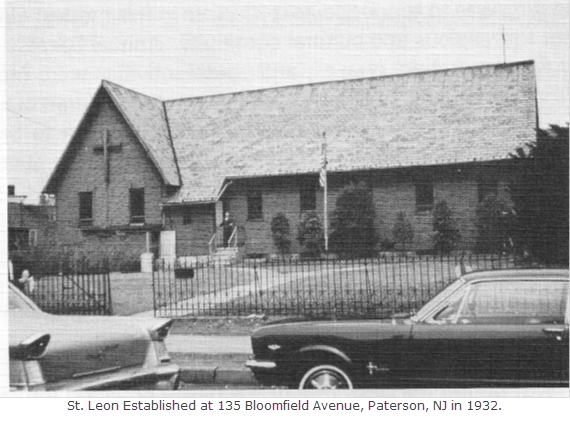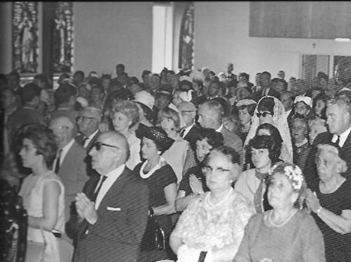| ||||||||||||
| ||||||||||||
|
History of our ParishOne Generation Follows Upon the Achievements of AnotherHistory of St. Leon Armenian Church St. Leon Armenian Church was established in 1932 at 135 Bloomfield Avenue in Paterson, New Jersey. Before the turn of the 20 th century, Armenian began to flee the persecution of the Ottoman Empire. Some of those Armenians settled in Paterson, known as “Silk City”, for being the busy hub of the silk weaving industry. They arrived in small numbers, with little money, but fortified by an ancient heritage. In those days, there were no parkways or turnpikes. The long roads were long, one of which led from Paterson in Passaic County to Union City, a city in Hudson County. Between 1906 & 1930, Armenians would journey by horse-car or trolley-car to Holy Cross Armenian Church in Union City, which was known as the “mother” church in the “New World” of New Jersey. They would go there to worship, to wed, and to baptize their children. Soon thereafter, the “mother” church had a healthy offspring, informally called the “Paterson Church”, which would later be consecrated as St. Leon Armenian Church. The Armenians of Paterson would often rent halls and churches for occasions when clergy would visit to celebrate liturgy or administer sacraments. During that time, Deacons would also do their best to serve their community with worship services. But by the late 1920s, the Armenians of Paterson developed a desire to have their own church and their own parish priest. Under the spiritual direction of the late Very Reverend Father Mampre Calfayan, who would later become Primate, a decision was made to purchase land for future use as a church site. Unfortunately for the Armenians of Paterson, the project, which was initiated in 1929, had to be abandoned because of the onset of the Great Depression. Just a few years later, in 1932, the persistence of the community did not relent, and a special meeting was held, presided over by the late Primate, Archbishop Ghevont Tourian. At that meeting, a committee was formed to raise funds for the purchase of a church for the Armenians of Paterson, whose number was already exceeding 500. As luck would have it, St. Luke Episcopal Church on Bloomfield Avenue in Paterson became available. It was purchased in that same year for $6,000, and despite a severe worldwide depression, the church’s mortgage was completely paid off within two years. For the next 33 years, the congregation called the modest church on Bloomfield Avenue “home”, where it maintained religious and cultural continuity. The community’s annual bazaars, pageants, Armenian and Sunday School classes, and youth activities were all organized and conducted in the church’s basement hall. It was during those years that the children of the community cultivated their values, and helped the church grow into an even larger family. The church fathers and lay leaders, seeing that growth, were faced with the task of building a larger church with an independent community center and educational facility. And it was the second generation, who grew up during those 33 years, which would help the church leaders meet that challenge. In 1958, through the efforts of the Parish Council, and the help of the late Haroutune Nakashian, three acres of land were purchased on Saddle River Road in Fair Lawn. The original plan was to first build a much-needed community center, which would then be followed by the building of a new church. In January of 1963, under the pastoral leadership of the newly ordained Reverend Father Carnig Hallajian, the original plan was reversed. His advice was simple and straightforward: “Build the church, and the people will come to wed, to baptize their children, and to bury their loved ones. The community hall will eventually be built.” Following the creation of an executive building committee, and the authorization by the Parish Assembly to build a church with an adequate sized basement to serve as a community hall, construction of the new church began in March of 1965 under the General Chairmanship of E. George Dabagian. Shortly thereafter, on September 19, 1965, the Primate of the Eastern Diocese, Archbishop Sion Manoogian, consecrated the newly erected St. Leon Armenian Church of Fair Lawn, NJ.
During the 1970s, the parish continued to thrive, welcoming many Armenians who were leaving the political unrest in the Middle East. St. Leon offered newcomers a spiritual home that bridged the gap to life in the United States. The newcomers, in turn, gave significant impetus to the Armenian cultural life of St. Leon’s parishioners. St. Leon was growing steadily in membership during the decade, and by 1980, once again a challenge presented itself to a modest people groomed in faith, hard work, and sacrifice. On February 3, 1980, the Parish Assembly created yet another executive building committee to plan an expansion project. On June 6, 1980, under the chairmanship of Zaven Dadekian, the building committee received authorization from a special Parish Assembly to proceed with construction of the long-awaited St. Leon Armenian Church Community Center, along with the conversion of the existing hall beneath the sanctuary into an educational wing of classrooms. On November 9, 1980, the late Archbishop Torkom Manoogian, then Primate of the Eastern Diocese, blessed the site of the proposed Community Center. Following plans prepared by Thomas Ashbahian, project architect with the firm of Mario B. Cammarano in Ridgewood, NJ, contracts were signed the following month with Joseph A. Natoli Construction of Pinebrook, NJ, and construction began as scheduled. With increasing attendance at Sunday worship, mushrooming enrollment in the church schools, and a full scale of parish activities burgeoning, there was a pressing need for even more space for educational and youth related activities. The St. Leon family stepped up to again “rebuild and reconstruct” its beloved Church. With dedication and witness to their faith, the 1988 Parish Assembly approved the new phase of construction that would expand the sanctuary and school facilities. However, due to the devastating earthquake in Armenia in December of 1988, the building project was tabled in order to direct all the available parish funds towards aiding Armenians in the homeland. By 1995, the Parish Assembly reviewed the previously approved expansion plans and assigned a committee to execute them. The project was spearheaded by two leaders of the community; Sarkis Gabrellian and Sarkis Soultanian. They, along with their enthusiastic committee, immediately began the task at hand. Within one year – and with minimal disruption to parish life – the work was completed. Divine Liturgy and all services were held within the sanctuary without interruption, and on November 17, 1996, according to the traditions of the Armenian Apostolic Church, Archbishop Khajag Barsamian, Primate of the Eastern Diocese, consecrated the newly renovated and added sections of the St. Leon.
| |||||||||||
| ||||||||||||




